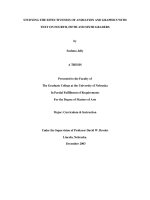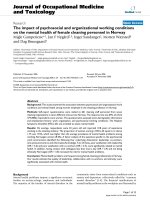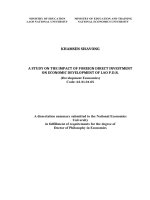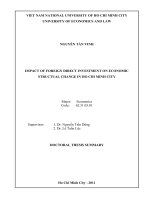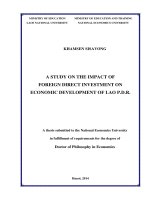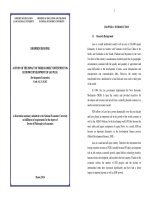The impacts of export and foreign direct investment on total factor productivity evidence from cross country analysis
Bạn đang xem bản rút gọn của tài liệu. Xem và tải ngay bản đầy đủ của tài liệu tại đây (1.18 MB, 92 trang )
UNIVERSITY OF ECONOMICS
HO CHI MINH CITY
VIETNAM
INSTITUTE OF SOCIAL STUDIES
THE HAGUE
THE NETHERLANDS
VIETNAM - NETHERLANDS
PROGRAMME FOR M.A IN DEVELOPMENT ECONOMICS
THE IMPACTS OF EXPORT AND FOREIGN
DIRECT INVESTMENT ON TOTAL FACTOR
PRODUCTIVITY: EVIDENCE FROM CROSS
COUNTRY ANALYSIS
BY
QUAN MINH QUOC BINH
MASTER OF ARTS IN DEVELOPMENT ECONOMICS
HO CHI MINH CITY, MARCH 2012
UNIVERSITY OF ECONOMICS
HO CHI MINH CITY
VIETNAM
INSTITUTE OF SOCIAL STUDIES
THE HAGUE
THE NETHERLANDS
VIETNAM - NETHERLANDS
PROGRAMME FOR M.A IN DEVELOPMENT ECONOMICS
THE IMPACTS OF EXPORT AND FOREIGN
DIRECT INVESTMENT ON TOTAL FACTOR
PRODUCTIVITY: EVIDENCE FROM CROSS
COUNTRY ANALYSIS
A thesis submitted in partial fulfilment of the requirements for the degree of
MASTER OF ARTS IN DEVELOPMENT ECONOMICS
By
QUAN MINH QUOC BINH
Academic Supervisors:
Assc. Prof. Dr. PHAM HOANG VAN
Assc. Prof. Dr. NGUYEN TRONG HOAI
HO CHI MINH CITY, MARCH 2012
CERTIFICATION
“I certify that the substance of this thesis has not already been submitted for any degree and
have not been currently submitted for any other degree.
I certify that to the best of my knowledge and help received in preparing this thesis and all
sources used have been acknowledged in this thesis.”
QUAN MINH QUOC BINH
ACKNOWLEDGMENTS
The process of writing a thesis is a collaborative experience involving the support
and helps from many people. I want to express my gratitude to those who give me the
tremendous support to complete this thesis.
I am deeply indebted to my parents for their invaluable support and constant
encouragement. From my early childhood, my parents always teach me valuable lessons on
the importance of learning. The boundless love of my parents have accompanied with me as
I continue my long journey on the pathway of intellectual acquisition.
Associate Professor Doctor Pham Hoang Van, Lecturer at Department of Economics,
Baylor University (USA), Fulbright Scholar, is a superb supervisor. He has encouraged me
to pursue this topic from the initial ideas to the final completion. His wholehearted guidance,
incredible patience, and useful discussions have enabled me to develop a deeply
understanding on my thesis.
Equally, I wish to express my heartfelt gratitude to Associate Professor Doctor
Nguyen Trong Hoai, Lecturer at Department of Economic Development, University of
Economics (HCMC), my second supervisor, for his valuable suggestions during the time I
write this thesis. His wide knowledge, excellent advice and logical way of thinking have
provided me a good basis in present this thesis.
I also take this chance to convey my warm and sincere thanks to Professor Arjun
Singh Bedi who have a remarkable influence on my love of academic research. His
constructive comments have great value in my study.
During my time at VNP, I receive a great encouragement and help from many
friends, and I am grateful to Ms Ngo Hoang Thao Trang, Ms Chau Ngoc Thao Nguyen, my
close friends, for motivating me to overcome all difficulties in my life. In addition, my
special thanks should send to Mr. Nguyen Dinh Quy (Programme Librarian) and Ms. Tang
Thi Xuan Hong (Programme Secretary) for their help and sharing of their resources to
complete this thesis successfully and in time.
Finally, I take a pride in myself for working very hard to finish this thesis. I realize
that after each success stories, there is a process of lots of hard works, difficulties, obstacles
and overcoming. Even in the hardest time when I write this thesis, I always believe that
great efforts will eventually to be paid off. Thank for the great time to learn and to grow up.
Quan Minh Quoc Binh
March 2012
ABSTRACT
We study the role of export and foreign direct investment on total factor productivity
growth in a sample of both developed and developing countries from 1996 to 2009. We start
by employing growth accounting exercise to estimate TFP growth of 103 countries and find
out it determinants. We also provide a global picture about TFPG’s performance of
countries in the world. By pointing out the limitations of previous researches that fail to take
into account the potential of endogeneity between FDI and TFPG as well as export and
TFPG, this thesis contributes to the current literature by developing two new instrumental
variables for export and FDI to overcome endogeneity problem. Two new instrumental
variable have proved their highly effectiveness in removing endogeneity bias. We carefully
check the robustness of our findings by employing panel data techniques to reestimate the
model that used in cross section exercise. We also employ one lagged value of FDI and
export to control for problem of reversed causality running from TFPG to export and FDI.
In empirical analysis, my research finds a robust and positive statistically significant
association between export and TFP growth. The finding emphasizes the indispensable role
of export in enhancing TFP growth. Interestingly, my thesis asserts the existence of negative
linkage between FDI and TFPG. This finding is sharply contrasts with conventional wisdom
of many people who think that FDI inflows will benefit for TFP growth.
From policy perspective, we recommend that a sound macroeconomic stability,
moderate government expenditure together with policies to foster export-oriented industries
are always needed for a better performance in TFP growth. We also suggest that government
should invest more in education to increase in quality and skill of human capital.
Government also needs to spend more money in training programs for the workforce to
learn how to apply advanced technology into production.
ABBREVIATIONS
FDI
Foreign Direct Investment
FEM
Fixed Effect Model
OLS
Ordinary Least Square
R&D
Research and Development
TFP
Total Factor Productivity
TFPG
Total Factor Productivity Growth
2SLS
Two Stage Least Square
TABLE OF CONTENTS
CHAPTER I: INTRODUCTION ....................................................................1
1.1.
Problem Statement ............................................................................................1
1.2.
Research Objectives ..........................................................................................2
1.3.
Research Questions ...........................................................................................2
1.4.
Research Methodology .....................................................................................2
1.5.
Organization of The Study ................................................................................3
CHAPTER II: LITERATURE REVIEW.....................................................4
2.1.
Total Factor Productivity ..................................................................................4
2.2.
Theoretical Background ....................................................................................5
2.2.1. Exogenous Growth Theory .....................................................................5
2.2.2. Endogenous Growth Theory ...................................................................6
2.2.2.1 Learning by Doing Model .........................................................6
2.2.2.2 R&D Model ...............................................................................7
2.3.
Determinants of TFP & TFPG ..........................................................................9
2.4.
Empirical Studies ............................................................................................17
2.5.
Conceptual Framework ...................................................................................24
CHAPTER III: RESEARCH METHODOLOGY...................................26
3.1.
Methods in TFP Level and TFP Growth Measure ..........................................26
3.1.1. The Regression Method ........................................................................26
3.1.2. The Growth Accounting Method .........................................................27
3.2.
Data Source .....................................................................................................28
3.2.1. Data for Dependent Variable TFPG......................................................29
3.2.2. Data for Independent Variables ............................................................30
3.3.
Model Specification ........................................................................................31
3.3.1. Model for Cross Section Data ...............................................................32
3.3.2. Definition of Variables used in Regression ...........................................35
3.3.3. Model for Panel Data ............................................................................40
CHAPTER IV: EMPIRICAL ANALYSIS.................................................42
4.1.
Overview of TFPG Performance in The World .............................................42
4.2.
Empirical Result .............................................................................................47
4.2.1. Empirical Result from Cross Section Data............................................47
4.2.2. Empirical Result from Panel Data .........................................................51
CHAPTER V: CONCLUSION AND RECOMMENDATIONS ........55
5.1.
Conclusion ......................................................................................................55
5.2.
Policy Recommendation .................................................................................56
5.3.
Limitations and further research .....................................................................57
REFERENCES..........................................................................................................59
APPENDIX ................................................................................................................65
LIST OF TABLES
Table 2.1: Summary of empirical studies relating to the determinants of TFPG .............18
Table 3.1: The definition of variables in the model ..........................................................39
Table 4.1: Cross Country Regression About The Determinants of TFPG........................48
Table 4.2: Panel Data Regression For The Determinants of TFPG ..................................53
Table A1: List of 103 countries in my sample ..................................................................65
Table A2: TFP growth (%) of 103 countries by regions from 1996 to 2009 ....................67
Table A3: Ranking of average TFPG rates (%) of 103 countries 2005-2009...................71
Table A4: Descriptive Statistics of Variables ...................................................................73
LIST OF FIGURES
Figure 2.1: Conceptual framework of determinants of TFPG ..........................................25
Figure 4.1: Trend of Total factor productivity growth......................................................42
LIST OF APPENDICES
Appendix 1: List of 103 countries in my sample ..............................................................65
Appendix 2: TFP growth (%) of 103 countries by regions ...............................................67
Appendix 3: Ranking of average TFP growth rates ..........................................................71
Appendix 4: Descriptive Statistics ....................................................................................73
Appendix 5: Regression Result From Cross Section Data ...............................................74
Appendix 6: Regression Result From Panel Data .............................................................79
Appendix 7: Statistical Tests.............................................................................................83
Chapter I
INTRODUCTION
1.1.
Problem Statement
It is widely believed that productivity or efficiency of an economy is the
most important determinant of income in the long run. Solow (1956) explained that
economic growth without technological progress (one source of productivity gains)
can not be sustained and would be stopped in the long run. Parente and Prescott
(2004) and Hall and Jones (1996) show that productivity differences explain the
large part of income differences across countries. Because of the importance of
productivity to income, many scholars and researchers have studied possible factors
that can affect productivity.
In recent years, cross border investment and trade activities have increased
remarkably despite the severe impacts of global financial crisis. In 2010, global
foreign direct investment (FDI) inflows increase $1.24 trillion, and it is expected to
rise further towards $1.6 - $2 trillions in 2012 (UNCTAD, 2011). More importantly,
FDI and trade are considered as important sources of economic growth, especially
for developing countries. However, the empirical question whether FDI and trade
benefit for productivity growth in different countries at different stage of
development is still a question of debated.
In this research, I study differences in productivity growth across countries in
the world from 1996-2009 and possible factors that affect productivity growth. In
particular, I look at export and foreign direct investment (FDI) as two channels
through which efficiency and productivity are affected. If we think of productivity
and efficiency as reflecting technology and production knowledge, then exports and
FDI are ways that best practices from the outside can be transmitted to the domestic
economy. While the impacts of export and FDI on economic growth have got plenty
attention by many scholars, the research on the impact of these factor on TFP still
lags behind. Until now, there are few studies of the impact of export and foreign
1
direct investment on TFP, and those empirical researches that take into account the
linkage of export or FDI on TFP fail to deal with endogeneity problem. My paper
contribute to the current literature by constructing new instrumental variables for
export and FDI, and we use a largest data set which includes more countries with
additional years, especially taken into account the impact of global financial crisis
on TFPG.
1.2.
Research Objectives
My main research objectives are listed below:
To measure productivity growth in 103 countries (including Vietnam) in the
period 1996-2009.
After that, I use data of productivity growth at the country level which is
calculated above to examine whether exporting and FDI has played any role in
increasing productivity in the world.
To suggest policies to speed up total factor productivity growth of countries in
the world.
1.3.
Research Questions
In order to achieve these objectives, my thesis is in an effort to find out
answers for the three following research questions:
a. How does productivity growth vary across countries?
b. Do exports have a positive impact on productivity growth at country level?
c. Does FDI has a positive impact on productivity growth at country level?
1.4.
Research Methodology
My research intended to use quantitative method by analyzing data of 103
countries from 1996 to 2009. First, I employ cross section data analysis to find out
the impacts of FDI and export on TFP. I also address the problem of endogeneity
which is the central of our empirical analysis. Because of the possibility of
endogeneity between export, FDI and TFP. I will instrument export by the land area
variable and FDI by lag FDI, distance from equator (latitude) and land area
variables, and I will run two stage least square regression (2SLS) with these
2
instruments. As a more comprehensive ways of robustness check, I also report the
result from panel regressions. The use of panel data has many advantages such as
we could control for unobserved heterogeneity and to rule out the bias of omitted
variable.
1.5.
Organization of the study
My paper consists of five main chapters. After this introduction chapter, the
remaining of this thesis is arranged as follow. Chapter 2 is the theoretical
framework to make sure that my research is built on a truly of scientific knowledge.
It widely discuss about definition of TFP and TFPG, present theoretical insights as
well as empirical works of previous scholars. Chapter 3 is the research
methodology. In this chapter, I will present methods to estimate TFP and TFPG,
and I also set up models to find out TFPG’s determinants. Chapter 4 is the empirical
analysis. The chapter first begin by present a global picture about performance of
TFPG of countries in the world. Next, the regression results from cross section and
panel data is presented. Chapter 5 draws conclusion of this research and recommend
policies in order to help law makers have better policies for Vietnam.
3
Chapter II
LITERATURE REVIEW
I begin this chapter by discussing some definition which involve to TFP and
TFPG. Next, the theoretical background of TFPG along with its determinants is
presented. And then it moves to the insights of empirical works in order to exhibit
the important role of FDI and export in TFPG.
2.1. Total Factor Productivity
Shim and Siegel (1992) defines productivity is “output per unit of input
employed”. Similarly, Hulten (2009) defines productivity as the ratio of real output
to a unit input. As we measure real output per unit of unique input including capital,
labor, we have definitions of “factor productivity” (such as capital productivity or
labor productivity). When we combine productivity of all factors of inputs, we have
definition of total factor productivity (Kopleman, 1986, p.3)
Comin (2008) states his definitions about total factor productivity in “The
New Palgrave Dictionary of Economics” as “Total factor productivity is the portion
of output not explained by the amount of inputs used in production”. Basing on this
definition, TFP represents how efficient and intense inputs are used in the
production to generate outputs.
Solow (1956) calls the output growth which can not be interpreted by input
growth as Total factor productivity growth (TFPG). Specifically, TFP growth is
considered as “Solow residual” from the production function. For example, TFP
growth can be derived by the subtraction of the growth rate of output and the
growth rate of input. He provides an insightful explanation for the differences in
cross-country TFPs which is caused by the differences in technology. In turn,
differences in technology across country will determine the differences in per capita
income of countries.
4
2.2.
Theoretical Background
All of the theories related to TFP and TFPG are created by researchers who
attempt to understand the growth process. In order to have a clearer picture about
TFP and TFPG, we should examine the underlying economic growth theories and
models. However, we only briefly review some milestones in theory that related to
TFP and TFPG. Almost literature of TFPG is originated from a long debate between
neoclassical economists and new growth economists.
2.2.1. Exogenous Growth Theory
Exogenous growth theory, which is known as “neoclassical growth theory”,
was independently developed by Nobel Prize winner Robert Solow (1956) and
prominent economist Trevor Swan (1956). Their model becomes a main branch of
economic growth theory during the years of 1950s and 1960s. Exogenous growth
model tries to explain for economic growth in the long run by exploring factors like
capital accumulation, the growth of population as well as productivity.
Exogenous growth model begins with a production function as presented
below:
Y = A(t)F( K, L )
(2.1)
with Y standing for output or income, K is the capital input, L is the labor input.
A(t) is the technological level or knowledge level, and A(t) is a function of time. In
this model, A(t) is assumed to grow at exogenous rate. Labor force L is also
assumed to grow at constant rate
From equation (2.1), we can produce the expression for output per capita
Y
K
A(t ) F ( )
L
L
(2.2)
From this equation, we can recognize that output per capita depend upon
capital per capita (
K
) and level of technology or knowledge A(t). However, capital
L
per worker is assumed to exhibit a diminishing return. That is, when we continue to
increase K, the contribution of K to output growth will decrease. We can think a
situation when we continue to equip our workers with more equipment, then
5
gradually extra equipment become redundant and marginal productivity of capital
will decrease. Hence, to have a positive output growth per capita in the long run,
then technology is a key determinant.
Neoclassical economists consider “technology progress” as a main source to
interpret for differences in income per capita of countries as long as determine long
run growth of economies. For instance, Solow (1956) explains that approximately
90 percent of income per capita growth in US is due to exogenous technology
progress. In a research for the contribution of physical capital, human capital and
technology to income difference between 127 countries in the world. Hall and Jones
(1999) find that technology progress contributes 8.3 while human capital and
physical capital contribute 1.8 and 2.2 to the differences in income, respectively.
However, neoclassical model treats technological progress as an exogenous
factor (that is determined outside the model as a “manna from heaven”). It provides
no insights for policy implications and leaves the driver of long run growth with
unexplained manners. To overcome limitations of neoclassical growth models, latter
economists have developed new growth theory that can explain sources of
technology progress as well as the reasons why it affect to economic growth.
2.2.2. Endogenous Growth Theory
Endogenous growth theory or new growth theory is an effort of economists
(Arrow(1962), Romer (1986), Lucas (1988), Rebelo (1991), and Grossman and
Helpman(1991)
to explain sources of technology progress. Instead of leaving
technology progress as unexplained factor, they attempt to explore the channels
which technology progress is affected. In endogenous growth theory, technology
progress occurs through innovation, investment in research and development, etc.
2.2.2.1 Learning by doing model of Arrow
Learning by doing concept mentions about ability of workers to improve
their productivity through repetition task and practice. In learning by doing model,
both comparative advantage and growth are involved to trade. Trade may change
the structure of specialization of a country, and impacts of trade rely on the level of
6
learning externalities. For intra-national spillovers, countries specialize in producing
goods with higher potential for learning will grow faster.
Learning by doing is first introduced by Arrow (1962). Arrow considers
technology progress as a part of economic activities. He states that although new
knowledge can be produced through repetition task, but it is decreasing. In order to
continue the learning by doing process, we need to stimulate this process by adding
new flow of capital. Hence, new investment is considered as a source of leaning by
doing. We will examine this model comprehensively in the production function take
the form of Cobb – Douglas:
Y BK L1
(2.4)
where Y is the output of economy, L is the labor force, K is the capital which
is included both physical and human capital. B is the level of knowledge increase
from learning by doing process.
As we mention above, the level of knowledge depend on new flow of capital.
Hence, we can write the level of knowledge as a function of capital.
B A.K 1
with A>0
(2.5)
From the learning by doing model, we can conclude that TFP is not an
exogenous factor as in neoclassical theory, and human knowledge is introduced as
another form of TFP.
2.2.2.2 Research and development model
Paul Romer is the pioneer in the introduction of R&D model. As pointed out
by Romer (1990), knowledge or ideas have characteristics of public good, which are
non-rival and non-excludable. Nevertheless, the use of some specific knowledge
can be excluded by legal protection. Firms which want to maximize the profits
usually engage in doing research, and through patent law they can protect their
inventions for a certain period. The existence of monopoly profits
provides
incentive for firms to invest in research and development activities. However, it is
seem imperfectly to exclude other firms from using the knowledge. When the
protection time of patent is over, others firms that operate in the same industry can
7
copy or imitate these knowledge. Hence, it is undoubtedly that research activity
from a firm also creates positive spillover effect for other firms.
We begin with the production function take the form of Cobb-Douglas (see
Jones (1995))
Y K ( ALY )1
(2.6)
where Y denotes for output, K is capital, A is stock of knowledge or technology,
which is already exist in the economy. We can simply understand A as
accumulation of all of knowledge that already been created by researchers in the
past.
This model consists of two sector. That is, R&D sector and good sector. The
particular role of good sector is to produce output for the economy, and R&D sector
is to create new technology or knowledge. Labor in the economy is employed to
produce goods (LY) or to research and create new ideas (LA). Labor is the economy
(L) equal: L = LY + LA. Model for R&D sector is:
A LA
(2.7)
where A denotes for new knowledge or new technology that have just
invented, is the rate at which new knowledge is created. This equation shows that
new technology (or total factor productivity growth) will increase with the
proportion of labor in research activities. In addition, we know that the rate which
researchers create new knowledge is a function of existence knowledge in the
economy and number of scientists (LA). We have:
A LA1
(2.8)
with is a constant parameter. LA1 represents amount of scientists to search
for new knowledge. If we increase amount of scientists, it is likely that the amount
of knowledge is reduce due to duplication same ideas.
Replace 2.7 into 2.8, we arrive at the production function for new
knowledge:
A LA A
8
(2.9)
It is clear from equation 2.9 that new technology (or knowledge ) depends on
amount of scientists and accumulation of knowledge.
This equation implies that countries which have bigger stock of knowledge
would experience faster total factor productivity growth. Second, countries invest
more in R&D also has higher TFP growth.
Discussion about theories that relates to TFP level and TFPG is very useful.
It helps us a clearer understanding about TFP as well as to find the answer for the
question “What is the theoretical determinants of TFP?”
2.3.
Determinants of TFP level and TFPG
In the neoclassical growth model developed by Solow (1956) and Swan
(1956), the fundamental sources of economic growth are capital accumulation as
well as technological progress. Saving plays an important role in capital
accumulation. To acquire technology progress, it is essential to have new
technology, therefore, changes in technology primarily have a strong impact on
TFP.
However, the later theories explain the term “TFP” as a measurement of
production efficiency. Having consider this definition, if any factor affects on input
and output relationship, it would have impact on TFP.
There are many factors influencing on both TFP level and TFP growth,
which is described in endogenous growth theory. In addition, it states that four
sources of TFP growth, including “economies of scale, resource allocation
efficiency, technology progress and human capital” are considered fundamental
sources (Huong 2001, p.15). From four fundamental sources, they help economists
find out many more factors which affect on TFP growth and TFP level through 4
these important channels such as FDI inflow, export, investment in human capital,
research and development, health, infrastructure, institution, technology transfer,
etc. Some of these factors will be mentioned next.
9
a) Foreign Direct Investment (FDI).
The question whether FDI benefits to productivity of recipient countries is
still a controversial question between scholars. Many economists believe that FDI is
good for productivity growth through technology transfer and technology diffusion
channels. Motivated by positive expectation of FDI, many developing countries
have numerous policies to attract flows of foreign direct investment, and they
consider FDI as an important external financing source to boost up economic
growth of their country. On the other hand, other scholars believe that FDI has no
particular impact on productivity growth. What is the argument for and against the
impacts of FDI on productivity growth? Does FDI really benefit for productivity of
recipient countries? In this part, we try to seek the theoretical answers for the these
question.
When invest and operate in a foreign country, multinational corporations
often face with many disadvantages and uncertainties. Potential drawback that
multinational corporations face is that they lack of understanding about foreign
markets and they don’t know much about laws as well as regulations of foreign
countries. To overcome these disadvantages, multinational corporations must
possess world advanced technology, and then it will transfer this technology to its
foreign affiliates in order to stay competition. Hence, FDI is widely seen as the
vehicle for technology transfer, it helps to bring advanced technology into the
recipient economy. Another point worth noting, FDI also creates positive spillover
effects such as knowledge spillovers to domestic firms. Domestic firms can learn
expertise management knowledge, marketing techniques and advanced production
methods from nearby foreign firms through “learning by seeing” process. In
addition, employees who work in multinational corporations also receives benefits
through strictly job training. Afterward, they may transfer these advanced
knowledge to local firms when they change career or they use these advanced
knowledge to set up their own business. For example, in an interesting research of
Javorcik and Spatareanu (2005) indicates that 25 percent of middle managers in
10
Czech and 15% percent of managers in Lavia acknowledge that they have study
skills and expertise management practices from multinational corporations.
Further more, increasing competition between multinational corporations and
local firms also makes local firms more productive by employing their resource in a
more efficient way to produce better goods and services.
Even though there are lots of theories to support the positive effects of FDI
on productivity, results from empirical studies for FDI-productivity nexus are still
ambiguous. At micro-level study, Aitken and Harrison (1999) find a negative
impact of FDI on total factor productivity growth among Venezuelan firms. They
explain for this negative relationship is due to “competition effect”. That
is,
multinational companies have technological advantages in producing goods and
services, so they attract customer’s demand from local firms. As a result, local
firms have to reduce its production and shift its average cost curve up. In addition,
Haddad and Harrison (1993) reach a similar conclusion for firms in Morocco.
Aitken et al. (1996) also conclude that there is existence the negative impact of FDI
on productivity when they conduct a research on Mexico and Venezuela firms. At
macro level study, Borensztein et al (1998) report a negative relationship between
FDI and economic growth of 69 developing countries. They point out that recipient
countries can only benefit from FDI inflows if recipient countries have sufficient
level of human capital. Similarly, Nelson and Phelps (1966), and Benhabib and
Spiegel (1994) interpret that if stock of human capital is weak recipient countries,
“absorptive capacity” or ability to learn from foreign firms will be limited. FDI
inflows then may have negative impact on productivity.
b) Export.
In literature, economists mention about two-way linkage of trade and
productivity.
The first linkage lays stress on important role of export on
productivity growth. The second refers to reverse linkage from productivity growth
to export. However, the pioneers of export-led development theory often emphasize
the indispensable role of exports in enhancing productivity and efficiency (Haddad,
11
De Melo and Horton (1996), and Baldwin (2003)). Export is an important tool to
achieve knowledge about production methods through learning by doing and
learning by exporting. In the model of learning by doing, Arrow (1962, p. 155)
defines that “Learning is the product of experience. Learning can only take place
through the attempt to solve a problem and therefore only takes place during
activity”. He (Arrow, 1962) also states countries specialize in producing and
exporting goods with higher potential for learning will grow faster. Learning by
exporting is a concept to describe the mechanism of enhancement productivity of
exporting firms when firms participate in export markets and exploit production
knowledge of trading partners. That is, in order to export to the foreign markets,
firms have to know about foreign customers and their demands. Furthermore, when
enter into international markets, local exporting firms have to obey rules about
quality of product as well as delivery conditions. To satisfy these strictly demands,
firms usually receive helps from foreign purchasers. Foreign purchasing partners
will teach firms how to manage production process more efficiently, how to control
product quality as well as training workers. As pointed out by Grossman and
Helpman (1991, p. 166) “When local goods are exported, the foreign purchasing
agents may suggest ways to improve the manufacturing process”. To stay
competition in international markets, exporting firms also have to learn advanced
technology and apply these technology into production process to produce quality
products to meet requirements of foreign customers. Therefore, exporting firms
could gain benefits from learning by doing and learning by exporting process.
Further more, by expanding their products to the foreign markets, firms have better
chance to obtain greater economies of scale. Economies of scale are improved when
the production costs are reduced by a bigger in sale volume, and again economies of
scale enhance productivity growth. Needless to say, there is a variety of convincing
empirical researches for why firms operate in exporting sectors are much more
productive than non-exporting sectors (see Bernard and Jensen (1999)). Last but not
least, thanks to export activities, exporting countries could gain foreign exchange
12
which is extreme shortage at many developing countries, and then they could import
high-tech products and modern machinery. This is also one important sources of
productivity.
Perhaps equally important, there is also another argument to argue the
reverse linkage from productivity growth to export. Accordingly, exporting firms
face with great difficulties and uncertainties when they enter into international
markets. In this regard, exporters first face with many kinds of trading cost such as
cost in searching for potential market, cost in setting up distribution networks and
transportation costs, etc. They also face with uncertainty about trading in foreign
markets. They have less knowledge about foreign regulations and they don’t know
much about demand of foreign customers than their foreign competitors. Because of
huge trading cost and uncertainty, only productive firms can bear these cost and
engage in export markets. Accordingly, Greenaway and Kneller (2007, p.135) assert
that “It has become something of a stylised fact that ex-ante productivity determines
the choice of whether or not to export. In other words, firms have to become more
productive before they export and causality runs from productivity to exports.
Causality in the opposite direction is less clear.” In addition, there is another ideas
that support for the reverse linkage from productivity growth to export. Clearly,
productivity growth of a country will be reflected in its price and its product’s
quality. That is, if a country is more productive, it will produce the product with
lower price and higher quality than other countries. Productivity of a country will
increase its competitiveness, and again this country could export more product than
other countries.
If we don’t take into account the reverse causality of export and productivity
growth in our model, the results will deliver biased coefficient. Hence, we apply
instrumental variable techniques to solve endogeneity problems.
13
c) Human Capital.
Human capital is the combination of skill, health, experience and knowledge
about the production of labor. Human capital is considered as a factor which
determines technology progress and technology efficiency. In the research and
development models, Aghion and Howitt (1998) and Romer (1990) find that
number of researchers (or human capital) helps to accelerate TFPG through
innovative new technology. In addition, Nelson and Phelps (1996) provide strong
evidences on the important of human capital on TFPG, these evidences reflect the
fact that countries with higher level of human capital can easily adopt and
implement advanced technology from the technological leader countries.
Further more, when evaluating the benefits of FDI inflows in recipient
countries, economists often use the term “absorptive capacity”. That is, the capacity
of recipient countries in using capital inflows without making a reduction in rate of
return of these capital. And productivity of the capital inflows will decline, if
amount of foreign investment capital employed in production grows faster than skill
or knowledge of workers about the production method (human capital). Borensztein
et al (1998) provides a strong empirical evidence that FDI inflows only benefits for
economic growth (or productivity) of recipient countries when recipient countries
have enough level of human capital. Since in developing countries usually have low
level of human capital, thus these countries can not fully exploit the benefits of FDI.
Hence, FDI may have negative impacts on economic growth (or productivity) in
these countries.
d) Research and development (R&D)
Economists (Grilliches and Mairesse (1991), Hall and Mairesse (1995)) have
widely accepted the positive link between research and development and
productivity growth. The idea simply is that investment in R&D stimulates
innovation. Innovation offer great opportunity for innovating firms to reduce
production cost as well as enable firms produce new products and services with
better quality from existing resources. R&D not only provides productivity and
14
profits for the firms that conduct R&D activity, it also bring benefits for other firms
that operate in the same industry through spillover effect. Further more, R&D
enable domestic countries to develop its absorptive capacity and adapt advanced
technology into production in a faster way.
e) Health
The connection of health and TFP growth seems to be closely associated.
Obviously, a healthy workforce will be more productive, and good health will help
workers improve their ability to adopt new technology. Poor health not only affects
to wealth and income of individuals but also to productivity of the economy. Taking
malaria as an example, the disease which indicates severe impact of poor health on
productivity. A person who suffer from malaria usually sick from 12-15 days and he
still feel headaches and fatigue after recovery. To some extent, malaria is not a fatal
diseases, but it lost working time of employee as well as their productivity. As a
result, labor supply for economy is reduced by poor health. Further more, in the
viewpoint of foreign investors, they less likely to invest in countries or areas where
there is high mortality rates and high disease burden. The rationale for their choice
is that workers suffer from illness will have lower working capacity and
productivity, and enterprises also bear higher production costs due to increase in
hiring and training cost for newly workers in replacing for illness workers who
absent from work. Hence, some developing countries located in tropical region
where suffers from infectious diseases is less likely to receive FDI inflows, and then
the potential for improving technology is limited. Poor health and diseases also
affect to human capital accumulation process through lower school attendance rates.
To this end, poor health and diseases may hinder productivity growth by making
resources are not distributed in efficient way. For instance, in some developing
countries, a large government expenditure have to spent on health care system such
as anti-malaria protection as well as fighting against undernourishment. Hence,
government budget to encourage R&D in private sectors is neglected.
15
f) Institution
Institution has a important role in economic growth and productivity growth.
According to Acemoglu and Robinson (2010), institution is the main factor to
explain for the differences of wealth across countries in the world. A good
institution can stimulate saving and investment as well as ensure an efficient
allocation of resource, and then result in higher TFP growth. For instance, Easterly
and Levine (2002, cited in Isaksson. 2007, p.42) report a situation where political
institutions ensure land rights for landholders. No doubt, these farmers have
incentive to invest in large scale production and enjoy benefit of economics of
scale. On the other hand, inappropriate institution and policies would have severe
impacts on productivity and economic growth. Acemoglu, Johnson and Robinson
(2001), for example, points out that institutions in colony countries did not secure
for private property rights or protect their citizens from risks of expropriation. As a
result, investment incentives are discouraged. Opportunities for investment,
innovation and acquiring foreign technology through FDI are also reduced. Further
more, North (1981), Mokyr (2002), Hall and Jones (1999) , and Ashraf and Galor
(2007) have presented evidence that good institutions will facilitate for advanced
technological research as well as knowledge diffusion.
g) Infrastructure
A good infrastructure system (road, electricity and water supply system) is
always needed to foster productivity and efficiency of economy. A good
infrastructure system helps to encourage investment, capital accumulation as well as
technology transfer. In their paper, Hall and Jones (1996) state that infrastructure is
the key to determine “why some countries have higher levels of productivity,
physical capital and human capital than others”. In addition, Aschauer (1989, cited
in Isaksson 2007, p. 29) finds out that the investment in infrastructure in the US
leads to the larger economic return to the society. He also states that the downturn
in productivity in the US in 1970s is largely due to a decreasing in public
infrastructure investment.
16

